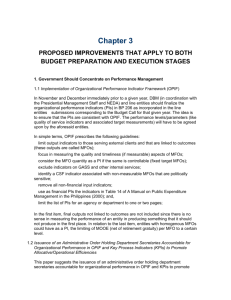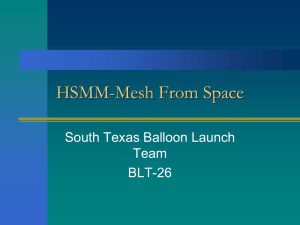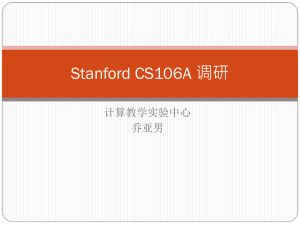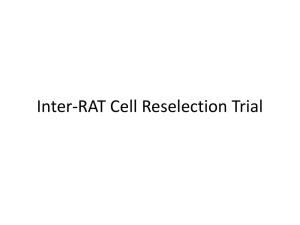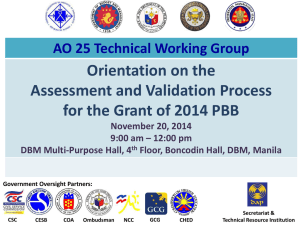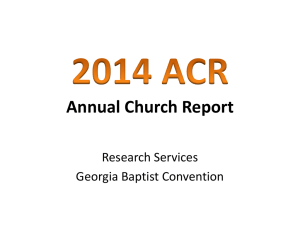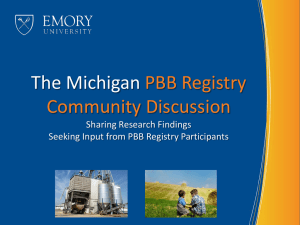File - Accounting Division
advertisement
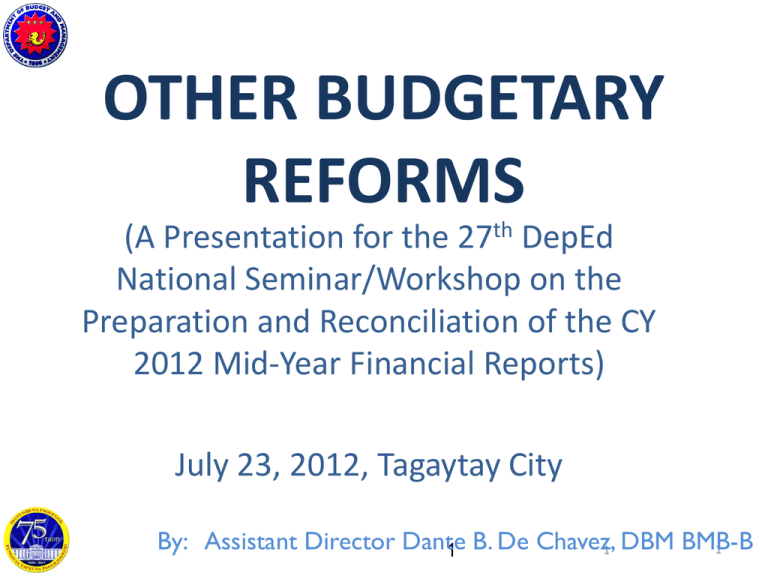
OTHER BUDGETARY REFORMS (A Presentation for the 27th DepEd National Seminar/Workshop on the Preparation and Reconciliation of the CY 2012 Mid-Year Financial Reports) July 23, 2012, Tagaytay City By: Assistant Director Dante 1 1 DBM BMB-B 1 B. De Chavez, OUTLINE OF PRESENTATION • National Budget Circular No. 532 • Creation of an Account Management Team (AMT) • Performance-Based Incentive System and Cascading of Performance Targets • Improving compliance with BEDs and BARs 2 2 National Budget Circular No. 532 Guidelines on the Review of Major Final Outputs (MFOs) and Performance Indicators (PIs) and Restructuring of Programs, Activities and Projects (PAPs) 3 3 3 Integrating OPIF into NEP(NBC 532) • Refine MFOs to capture mandates/business lines of department • Have an integrated set of performance indicators (PIs) w/c cover quantity, quality, timeliness, cost • Restructure PAPs to establish links with MFOs for better cost estimation and expn. Prioritization • Develop standards for OPIF throughout government by applying common methodology to the exercise 4 4 4 Creation of an Account Management Team (AMT) 5 5 5 Goal of the AMT • DBM as the expert on expenditure management should be able to nudge, in coordination with the departments/agencies, their spending levels and rates to align them to the DBCC quarterly disbursement targets to support growth target. 6 6 Functions • Come up with new initiatives to improve performance such as reviewing internal processes in formulating MCPs, and adjust MCPs for the rest of the year, in the context of DBCC targets ; • Review and assist in improving internal processes in recording/consolidating financial reports from the lowest operating units to the central office for timely submission to DBM; • Develop metrics, leading indicators (e.g., bidding schedules), to guide departments towards achieving monthly and quarterly disbursement targets; 7 7 Functions • Draw up strategy maps showing cause-effect linkages towards achieving financial targets (horizontal – internal workflow processes; vertical – top-down manner, i.e., top management down to middle management to offices at the regional /district/provincial/school) • Assess regularly the financial performance of the departments; • Update scorecards monthly: financial, nonfinancial, internal processes 8 8 Expected Output • Revised MCPs for Quarters 2 to 4 of the current year, with monthly breakdown and assumptions; • Justification/s for below target performance during quarter 1 and factors affecting performance; • Proposed measures or catch-up plans to improve financial performance for the rest of the year; and • Summary of Observations, Findings, and Recommendations 9 9 Schedule of Meetings and Reporting • Meet regularly twice a month -first and last weeks of the month • Submit report thru the BTS (re: progress of work of each individual department) 10 10 Performance-Based Incentive System and Cascading of Performance Targets 11 11 11 Inter-Agency Task Force on Harmonization of National Government Performance Monitoring, Information and Reporting Systems (Administrative Order No. 25, s. 2011) Task Force Members: NEDA DBM OP DOF PMS Government Oversight Partners: CSC CESB COA Ombudsman NCC GCG CHED Technical Secretariat: 12 12 Outputs of the Task Force 1. Harmonized Results-Based Performance Management System (RBPMS) • Using the Five KRAs, OPIF and the RM as underlying frameworks • RBPMS as basis and transparency mechanism of the performance-based incentives 2. Performance-Based Incentive (PBI) System 13 13 Harmonized Results-based Performance Management System (RBPMS) Societal Goals/Outcomes SONA/ SER SocioEconomic Report Sectoral Goals/Outcomes Good Governance and AntiCorruption Human Development & Poverty Reduction Economic Development Security, Justice, and Peace Climate Change Adaptation PPARC Priority Program Accountability Report Card Organizational Outcomes MARC- I Major Final Outputs (Citizen-focused Service & Product Results) Financial Stewardship Internal Process Leadership, Learning and Growth MFO Accountability Report Card MARC- II Management Accountability Report Card Strategic Performance Management System (Individual) 14 14 To quality for PBB, agencies must meet at least 90% of PPARC and MARC-I, and satisfy MARC-II (good governance conditions) Draft EO Directing the Adoption of a Performance-Based Incentive (PBI) System for Government Employees 15 15 Performance-Based Incentive System PBI system consisting of the Productivity Enhancement Incentive (PEI) and the Performance-Based Bonus (PBB) shall be adopted in the national government beginning FY 2012. 1. PEI at P5,000 shall continually be granted across-the- board 2. PBB, which is a top-up bonus, shall be given to personnel of bureaus or delivery units in accordance with their contribution to the accomplishment of their Department’s overall targets and commitments 16 16 Adoption of a PBI System • Flexibility shall be given to heads of departments to suit the PBB system to the nature of their operations • Adoption of a communications strategy and publication of performance targets and accomplishments in the website to ensure transparency and accountability 17 17 Criteria and Conditions to qualify for PBB 1. Achieved at least 90% of MFO targets and Priority Program targets agreed with the President under the five Key Result Areas of EO 43 2. Meet 2 to 3 good governance conditions/ requirements set by the AO 25 Task Force annually under the performance drivers of the RBPMS 3. Bureaus within the department meeting above conditions are forced ranked and the personnel within them 18 18 18 Performance Categories (1) Department Secretaries shall rank the bureaus or delivery units, including attached agencies, according to their performance following a normal distribution. Bureaus/Delivery Units Distribution Rating 10% Best 25% Better 50% Good 15% Poor 19 19 Performance Categories (2) For 2012, the Bureau Heads shall rate employees using their respective Performance Appraisal Systems Personnel within the Bureaus/Delivery Units Distribution 10% 25% 65% Rating Best Better Good Below Satisfactory Rating – No PBB 20 20 PBB Rates of Incentives Individual Category Bureau Category Best Performer Better Performer Good Performer Best Bureau 35,000 20,000 10,000 Better Bureau 25,000 13,500 7,000 Good Bureau 15,000 10,000 5,000 21 21 Coverage All Departments/Agencies, other Offices of the National Government, State Universities and Colleges (SUCs), and Government-Owned or-Controlled Corporations (GOCCs) are covered. The Governance Commission on GOCCs (GCG) is encouraged to adopt the policies and principles in the EO and issue guidelines for GOCCs covered under RA 10149, pending formulation of a compensation system for GOCCs. 22 22 Implementation Schedule Executive Briefings/ Orientations Cascading Workshops with Agencies Consultation/ Coaching of Agencies (July 2012) (July 2012) (July 2012) Submission of Accomplishment Reports Review/Approval of Agency Performance Targets Submission of Cascaded Performance Targets (1st week of December) (September) Evaluation of Performance Grant of Bonus (2nd week of December) (August 2012) (4th week of December) 23 23 (Proposed) Circular on the Cascading of Department Performance Targets to Bureau Level or Equivalent Offices 24 24 Criteria for the Grant of PBB • In order to be eligible for the PBB, the department/agency should cascade its MFO performance targets, as declared in the OPIF and those targets under the 5 Key Result Areas of the President’s Social Contract, into bureau or equivalent office-level targets. 25 25 Guidelines in Cascading Department Targets (1) • Review MFOs, PIs, and targets as declared in the OPIF Book of Outputs for CY 2012, and the key program/project targets related to the 5 Key Result Areas • Select or prioritize at least 3 performance indicators for each MFO to capture the dimensions of quantity, quality, and timeliness • Key programs/projects with performance targets for CY 2012 agreed with the President shall also be included 26 26 Guidelines in Cascading Department Targets (2) • Identify component bureaus/equivalent offices responsible for the delivery of the MFOs and those belonging to STO & GASS • The department must submit to DBM the revised MFOs, PIs and PTs together with the original ones if there are adjustments needed in its specification 27 27 Timelines in Cascading Department Targets • Submission to the DBM of the accomplished templates not later than August 30, 2012 • DBM shall review and approve submissions as to the consistency of identified bureau/office/unit targets with the overall department/agency performance targets • Approved cascaded MFOs, PIs and PTs and quarterly accomplishments Department/agencies shall be published in department/agency websites or official publications for transparency 28 28 Schedule of Activities (1) Date Activity Target Participants Role of Interagency Counterparts July 12 (am) Briefing with BMBs of DBM DBM BMBs July 12 (pm) Briefing of CSC, CESB, CHED, NEDA counterparts (who will join composite team) CSC Field Directors, sector staffs from NEDA, CESB, CHED participants Participants; identify their BMB counterparts July 1620 Executive Briefing by Cluster Heads of Departments and Undersecretaries Concerned Interagency counterpart to observe July 25Aug 2 Workshop on Cascading Performance Targets for Agencies (by Cluster) Undersecretary for Finance and Admin, Planning Officer, Budget Officer, Finance Officer Counterparts to assist covered agencies in selecting strategic PIs, cascading PTs and to check consistency with Cluster targets, President’s directives, RM July 25 – August 25 Consultation/Coaching of Agencies (on need basis) Agencies needing assistance Counterparts to lend assistance, monitor progress and compliance of covered agencies 29 29 Schedule of Cascading Workshops Date Clusters Responsible Task Assigned BMB/ Force Member (to be Oversight Agency identified) July 25 -Economic Development - Constitutional Bodies DOF Secretary/ NEDA BMB- A, C, D, CSC, CESB, Secretary NEDA July 26 -Security, Justice and Peace -Climate Change Adaptation and Mitigation - Human Development and Poverty Reduction DBM Secretary/ OES/OP/ CSC Chair BMB- A, B, D, E, F, CSC, CESB, NEDA, July 30 OEOs (batch 1 and 2) OES/PMS All BMBs, CSC, CESB, NEDA, GCG Aug 2 OEOs (batch 3) OES/PMS All BMBs, CSC, CESB, NEDA, GCG July 31 SUCs CHED Chair 30 CHED, BMB- B, DBM30 CESB, NEDA ROs, CSC, July 27 Schedule of Activities (2) Date Activity Target Participants Role of Interagency counterparts On or before August 30 Submission of Cascaded Performance Targets of Agencies All agencies On or before September 15 First-pass Review Agency submission September 17-21 Second-pass Review of Agency Performance Targets By Task Force BMBs, CHED, GCG to present evaluation to the Task Force September 22-30 Final-review and issuance of notices of approval By DBM BMBs, CHED, GCG to prepare notices; coordinate with covered agencies; monitor compliance re: posting GCG to receive the submission of covered GOCCs; furnish e-copy TF Secretariat; CHED to receive the submission of SUCs Interagency counterparts to join BMB review of covered agencies; CHED in consultation with DBM counterparts to review submission of SUCs for consistency with OPIF Book of Outputs FY 2012, HERA, Cluster targets; forward evaluation/recommendation to DBM GCG to review submission of GOCCs; forward evaluation/recommendation to DBM 31 31 Schedule of Activities (3) Date Activity Target Participants Role of BMBs October Conversion of Agency Performance Targets into Agency Scorecards All agencies Counterparts to assist the TF Secretariat in checking the Scorecards for consistency 2nd week October Submission of Agency Accomplishment Report as of 3rd Qtr All agencies BMBs/CHED/GCG to evaluate agency accomplishments-to-date vis-à-vis targets; monitor compliance with deadlines 1st week of December Submission of Agency Accomplishment Report as of EO November All agencies BMB/CHED/GCG s to monitor submission 2nd week of December Evaluation of Agency Performance By DBM and counterparts from oversight agencies Counterparts to evaluate accomplishments vis-à-vis targets of covered agencies 3rd week of December Presentation of Evaluation to the TF and multi-sectoral review body Task Force, multisectoral review body BMBs/CHED/GCG to present evaluation 4th week of December Grant of Bonus Qualified agencies BMBs/CHED/GCG to prepare notices and coordinate release of bonus 32 32 Improving compliance with BEDs and BARs 33 33 33 BEDs/BARs Type of Report Form No. Period of Submission A. ANNUAL BEDs Physical and Financial Plan BED 1 Monthly Cash Program BED 2 On or before Estimate of Monthly Income BED 3 Feb. 15 each List of Not Yet Due and Demandable Obligations BED 4 year Quarterly Physical Report of Operation BAR 1 On or before Quarterly Financial Report of Operation BAR 2 the 10th day Quarterly Report of Income BAR 3 ff. the qtr. B. BARs QUARTERLY 34 BEDs/BARs Type of Report Form No. Period of Submission B. BARs MONTHLY Statement of Allotment, Obligations and On or before Balances Quarterly Report of Income BAR 4 the 10th day BAR 5 of the ff. month 35 Improving agency compliance of BEDs and BARs to DBM Remind agencies thru call-up letters / phone; Encourage on-line submission of reports i.e. SAOB; Close coordination with agencies and provide technical assistance, if necessary; Post in the DBM website, the reports submitted by agencies and highlight the agencies with no submission; Implement the “no-report, no-release” policy. 36 36 37 37
